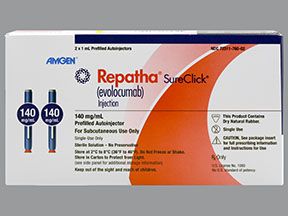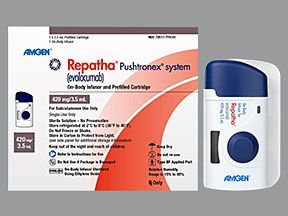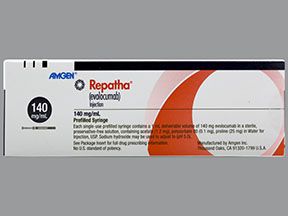If you have certain kinds of high cholesterol or heart disease, your doctor might suggest Repatha as a treatment option.
It’s a prescription drug with the following uses:
- to decrease low-density lipoprotein (LDL) cholesterol (together with a cholesterol-lowering diet and sometimes other cholesterol-lowering drugs)
- in adults with high cholesterol
- in adults and some children with homozygous familial hypercholesterolemia (HoFH) or heterozygous familial hypercholesterolemia (HeFH)
- to reduce the risk of stroke, heart attack, and the need for surgery to improve blood flow to the heart, in adults with heart disease
Repatha comes as a liquid solution that you inject under your skin. It contains the active ingredient evolocumab. (This is what makes the drug work.) Repatha is a biologic, which means it’s made from living cells. It belongs to a group of drugs called PCSK9 inhibitors, which help lower LDL cholesterol.
This article describes the dosages of Repatha, as well as its strengths and how to use it. To learn more about the drug, see this in-depth article.
Note: This article covers Repatha’s usual dosages, which are provided by the drugmaker. But when using Repatha, always use the dosage your doctor prescribes.
Learn more about Repatha’s typical doses and dosage frequency below. The dosage recommended for you will depend on:
- the condition you’re using Repatha to treat
- other drugs you’re taking
- how your body responds to Repatha over time
Note: This chart highlights the basics of Repatha’s dosage. Be sure to read on for more detail.
| Repatha forms | Repatha strengths | Repatha dosages |
| • prefilled syringe • SureClick autoinjector | • 140 milligrams (mg)/milliliter (mL) | • 140 mg every 2 weeks, or • 420 mg every 2 weeks, or • 420 mg monthly |
| • Pushtronex system | • 420 mg/3.5 mL | • 420 mg monthly, or • 420 mg every 2 weeks |
What are the forms of Repatha?
Repatha comes as a liquid solution that you inject under your skin. It’s available in the following forms:
- prefilled syringe
- SureClick autoinjector
- Pushtronex system
What strengths does Repatha come in?
Repatha comes in the following strengths:
- 140 mg/mL
- 420 mg/3.5 mL
What are the usual dosages of Repatha?
Your doctor will likely start you on a low dosage of Repatha. They may increase that dosage if it doesn’t provide the desired result. They’ll ultimately prescribe the smallest dosage that works for you.
The information below describes dosages that are commonly used or recommended. But be sure to take the dosage your doctor prescribes for you. They’ll determine the best dosage to fit your needs.
Dosage for certain adults with heart disease or high cholesterol, including inherited heterozygous familial hypercholesterolemia (HeFH)
Repatha is used to reduce the risk of stroke, heart attack, and the need for surgery to improve blood flow to the heart in adults with heart disease.
It’s used together with diet and sometimes other cholesterol-lowering drugs to reduce low-density lipoprotein (LDL) cholesterol. For this use, it’s prescribed for adults with high cholesterol, as well as adults and some children with HeFH.
For these uses, the typical dosage of Repatha is either:
- a 140-mg injection every 2 weeks
- a 420-mg injection every month
Dosage for adults with inherited homozygous familial hypercholesterolemia (HoFH)
Repatha is used, along with diet and other cholesterol-lowering drugs, to decrease low-density lipoprotein (LDL) cholesterol in adults with HoFH.
For this use, the starting dosage is usually a 420-mg injection under your skin once each month. If the drug isn’t working well enough after 12 weeks, your doctor may increase your dosage to 420 mg every 2 weeks.
If you’re also receiving LDL apheresis (a process to remove LDL cholesterol from your blood), you’ll likely start Repatha after that treatment session ends. In this case, your starting dose may be a 420-mg injection every 2 weeks.
What’s the dosage of Repatha for children?
Repatha is only used in children ages 10 years or older.
Dosage for children with heterozygous familial hypercholesterolemia (HeFH)
The usual dosage of Repatha for HeFH in children ages 10 years and older is:
- a 140-mg injection every 2 weeks
- a 420-mg injection every month
Dosage for children with homozygous familial hypercholesterolemia (HoFH)
The usual dosage of Repatha for HoFH in children ages 10 years and older is a 420-mg injection once each month.
Dosage increases and the dosage for those receiving LDL apheresis are similar to those for adults. (See the section above.)
Is Repatha used long term?
Yes, Repatha is usually used as a long-term treatment. How long you use Repatha will depend on how well the drug works for you. If you and your doctor determine it’s safe and effective for your condition, you’ll likely use it long term.
Repatha comes as a liquid solution you inject under your skin. You can ask your doctor or pharmacist for a demonstration of how to inject the drug correctly.
The injection instructions you follow will differ depending on the form of Repatha your doctor prescribes. Read the specific instructions for your prescribed injection form (SureClick autoinjector, Pushtronex system, or prefilled syringe) on the drugmaker’s website.
General guidelines apply when you inject Repatha:
- Store the drug container in the refrigerator in its original packaging.
- Do not use the same injection site for two scheduled doses in a row.
- Avoid injecting into skin that is discolored, broken, hard, tender, or has stretch marks.
- Clean and dry the injection site before injecting Repatha.
- Throw away any used medication in a hard plastic container for sharp objects.
If you need more help administering the drug, you can enroll in the RepathaReady program. Nurses are available by phone or video to help you learn more about how to inject your dose. You can call 844-REPATHA (844-737-2842) to enroll.
For information on the expiration, storage, and disposal of Repatha, see this article.
Accessible drug containers and labels
If you find it hard to read the prescription label on your medication, tell your doctor or pharmacist. Some pharmacies provide medication labels that:
- have large print or use braille
- feature a code you can scan with a smartphone to change the text to audio
Your doctor or pharmacist may be able to recommend pharmacies that offer these accessibility features if your current pharmacy doesn’t.
The dosage of Repatha you’re prescribed may depend on several factors. These include:
- the type and severity of the condition you’re using the drug to treat
- your age
- the form of Repatha you’re using
- other treatments you take for high cholesterol
- how well the drug is working
The instructions for injecting a missed Repatha dose depend on your dosage schedule.
For doses given every 2 weeks. If it’s still within 7 days of your missed dose, give yourself the injection and resume your dosing schedule. If it’s more than 7 days after your missed dose, wait until your next scheduled dose and resume your dosing schedule.
For doses given once every month. Give yourself the Repatha injection on the day you realize you missed the dose. Use the day you gave the injection as the start day of a new dosing schedule.
If you need help remembering to inject your dose of Repatha on time, try using a medication reminder. This can include setting an alarm or downloading a reminder app on your phone. You can also mark your dosing schedule on a paper calendar if that works better for you.
Do not inject more Repatha than your doctor prescribes, as this can lead to serious side effects.
What to do in case you inject too much Repatha
Call your doctor right away if you think you’ve injected too much Repatha. You can also call 800-222-1222 to reach the American Association of Poison Control Centers or use its online resource. But if you have severe symptoms, immediately call 911 (or your local emergency number) or go to the nearest emergency room.
Below are answers to some commonly asked questions about Repatha’s dosage.
How often do I have to switch to a different injection site for my Repatha dose?
The drugmaker suggests switching your injection site every time you use Repatha. You can use the same site again for a later injection. Injection sites include the thigh, upper arm, and belly.
Can I inject my Repatha dose using the prefilled syringe if I’m allergic to latex?
Maybe. It depends on how severe your latex allergy is. The needle cover on the Repatha prefilled syringe and the SureClick autoinjector contains a latex-like material that may cause an allergic reaction. If you’re allergic to latex, talk with your doctor about how to safely use Repatha.
What’s the Pushtronex system?
The Pushtronex system is a device you stick to your body in order to give your Repatha injection slowly. The drugmaker calls it a single-dose, on-body infusor. It still uses a needle like the prefilled syringe, but this injection takes about 5 minutes to complete.
Talk with your doctor about this method of taking Repatha if you have trouble using the prefilled syringe or SureClick autoinjector.
The sections above describe the usual dosages provided by the drugmaker. If your doctor recommends Repatha for you, they’ll prescribe the dosage that’s right for you.
Remember, you should not change your dosage of Repatha without your doctor’s recommendation. Only use Repatha exactly as prescribed. Talk with your doctor if you have questions or concerns about your current dosage. Here are some examples of questions you may want to ask:
- Should I start on the lower or higher dose of Repatha?
- Would a different Repatha dose decrease my risks of side effects?
- Will I get the prefilled syringe, the SureClick, or the Pushtronex system?
- Will the dosages of my other cholesterol-lowering drugs change if my Repatha dosage increases?
To learn more about Repatha, see these articles:
- All About Repatha
- Repatha and Cost: What You Need to Know
- Side Effects of Repatha: What You Need to Know
To get information on different conditions and tips for improving your health, subscribe to any of Healthline’s newsletters. You may also want to check out the online communities at Bezzy. It’s a place where people with certain conditions can find support and connect with others.
Disclaimer: Healthline has made every effort to make certain that all information is factually correct, comprehensive, and up to date. However, this article should not be used as a substitute for the knowledge and expertise of a licensed healthcare professional. You should always consult your doctor or another healthcare professional before taking any medication. The drug information contained herein is subject to change and is not intended to cover all possible uses, directions, precautions, warnings, drug interactions, allergic reactions, or adverse effects. The absence of warnings or other information for a given drug does not indicate that the drug or drug combination is safe, effective, or appropriate for all patients or all specific uses.



